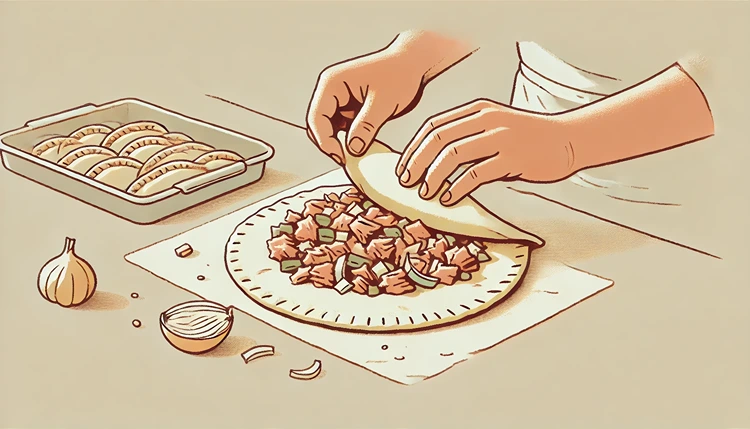Empanadas are one of Spain’s most beloved dishes, and they vary dramatically from region to region. These golden, flaky pastries are packed with flavorful fillings, ranging from meats and seafood to vegetables and cheeses. Each region of Spain has its unique take on the classic empanada, making it not just a tasty snack but a deep expression of local culture. Whether baked or fried, empanadas have earned their place in Spanish cuisine as a comfort food staple.
Today, we’ll explore some of the best regional recipes for making Spanish empanadas, highlighting their unique characteristics and flavors. From Galicia’s famous tuna empanadas to the hearty meat-filled versions from Andalusia, there’s an empanada recipe for everyone.
Helpful Hint:
Spanish empanadas are great for meal prep! They freeze well, making them perfect for quick meals throughout the week. Just pop them in the oven or microwave, and they’re good to go!
What’s the Best Flour to Use for Empanada Dough?
A common question among those looking to recreate authentic Spanish empanadas at home is what type of flour to use. In most traditional recipes, all-purpose flour is the go-to option for empanada dough. It strikes the perfect balance between being soft and durable enough to hold the hearty fillings without falling apart. Some regions, like Galicia, may opt for a mixture of wheat and corn flours, adding a unique texture to the dough.
Using high-quality flour can make all the difference. Look for unbleached, high-protein flour to get that perfect golden crust. Adding a little bit of egg or butter to the dough will enhance the flavor and create a richer, flakier texture.
How Do Different Spanish Regions Influence Empanada Fillings?
The beauty of Spanish empanadas lies in their diversity. Different regions of Spain put their own spin on this iconic dish, creating a variety of fillings that showcase local ingredients and culinary traditions.
Galician Empanada: Tuna and Onions
Galicia, located in the northwest of Spain, is renowned for its seafood, and it’s no surprise that its signature empanada reflects that. The Empanada Gallega often features tuna, onions, and bell peppers encased in a flaky dough. The filling is seasoned with olive oil and sometimes spiced with paprika for an extra kick.
This empanada is typically baked in large slabs and then cut into squares, perfect for serving at family gatherings or local festivals. Tuna is a common filling, but other seafood like mussels or sardines may also be used depending on the season.
Stats:
According to a 2022 survey on Galician cuisine, 85% of locals named tuna empanada as their favorite dish to bring to community events.
Andalusian Empanada: Meat and Spices
Andalusia, located in southern Spain, offers a heartier take on empanadas. Here, you’ll find empanadas filled with ground beef, pork, or chicken, mixed with onions, garlic, and an array of spices. Some versions even incorporate raisins or hard-boiled eggs to add a hint of sweetness and texture.
The dough in Andalusian empanadas is slightly denser, with a deep golden color, thanks to the use of egg yolks. This region’s empanadas are often fried, making them crispy and perfect for snacking on the go.
How to Make Authentic Galician Tuna Empanadas at Home
If you’re a fan of seafood, the Galician tuna empanada is a must-try. Here’s how to make it at home:
Ingredients
- 3 cups all-purpose flour
- 1/2 cup olive oil
- 1/2 cup water
- 1 egg
- 2 cans of tuna in olive oil
- 1 large onion, chopped
- 1 red bell pepper, diced
- 2 cloves of garlic, minced
- 1 tsp paprika
- Salt and pepper to taste
Instructions
- Preheat your oven to 375°F (190°C).
- To make the dough, combine flour, olive oil, and water in a bowl. Mix until a dough forms, then knead for about 5 minutes.
- Roll out the dough into two large circles, about 1/4 inch thick.
- In a pan, sauté the onions, garlic, and bell pepper until soft. Add the tuna, paprika, salt, and pepper, mixing well.
- Spread the filling onto one of the dough circles, leaving a small border around the edges.
- Place the second dough circle on top and pinch the edges together to seal.
- Brush the top with a beaten egg and bake for 30-35 minutes, or until golden brown.
Why Do Empanadas Differ from Region to Region?
Empanadas in Spain reflect the country’s rich culinary diversity, shaped by geography, climate, and local ingredients. In coastal regions like Galicia, seafood reigns supreme, while in the interior, meat-based empanadas are more common. Each variation tells a story of Spain’s history and the cultural influences that have shaped its cuisine over centuries.
Helpful Hint:
If you’re short on time, pre-made dough can be a lifesaver! Look for empanada dough in the frozen section of your local supermarket for a quick and easy alternative to homemade dough.
Regional Empanada Flavor Profiles
| Region | Common Fillings | Dough Type | Cooking Method |
|---|---|---|---|
| Galicia | Tuna, onions, bell peppers | Thicker, olive oil-based | Baked |
| Catalonia | Spinach, raisins, pine nuts | Thinner, flaky dough | Baked |
| Andalusia | Meat, hard-boiled eggs, spices | Richer, golden dough | Fried |
| Basque Country | Salted cod, anchovies | Light, pastry-like dough | Baked or Fried |
Exploring Catalonian Empanadas: A Taste of Tradition
Catalonia, located in northeastern Spain, has its own take on empanadas, which are heavily influenced by the region’s Mediterranean climate and abundance of fresh ingredients. Unlike the hearty, meat-heavy empanadas from southern Spain, Catalonian empanadas often feature lighter fillings with vegetables, cheeses, and sometimes seafood.
Empanada de Espinacas: Spinach and Raisins
One of the most popular empanadas in Catalonia is the Empanada de Espinacas, which combines spinach, pine nuts, and raisins. The sweetness of the raisins contrasts beautifully with the earthiness of the spinach, while the pine nuts add a lovely crunch. It’s a vegetarian-friendly option that feels both light and satisfying, making it a perfect appetizer or snack.
This empanada is typically baked rather than fried, giving it a soft and flaky crust that complements the delicate filling. The dough used in Catalonia tends to be slightly thinner than in other regions, allowing the filling to really shine.
How to Make Spinach Empanadas at Home
If you’re looking for a delicious and lighter empanada option, try this Catalonian recipe for spinach empanadas:
Ingredients
- 3 cups all-purpose flour
- 1/2 cup olive oil
- 1/2 cup water
- 1 egg
- 2 cups fresh spinach, chopped
- 1/4 cup pine nuts
- 1/4 cup raisins
- 2 cloves garlic, minced
- Salt and pepper to taste
Instructions
- Preheat your oven to 375°F (190°C).
- To make the dough, mix the flour, olive oil, water, and egg in a bowl until a dough forms. Knead the dough for about 5 minutes, then let it rest for 10 minutes.
- In a pan, sauté the garlic and spinach until the spinach wilts. Add the pine nuts and raisins, seasoning with salt and pepper.
- Roll out the dough into two circles, about 1/4 inch thick.
- Spoon the spinach mixture onto one dough circle, leaving a border around the edges.
- Place the second dough circle on top and seal the edges by pressing them together with a fork.
- Bake for 25-30 minutes or until golden brown.
What Makes Andalusian Empanadas Stand Out?
Andalusia, known for its bold flavors and Moorish influence, brings a completely different flavor profile to its empanadas. In this region, empanadas are often packed with spices such as cumin, cinnamon, and saffron, giving them a distinct, aromatic quality. The fillings are typically rich and hearty, with a variety of meats and sometimes dried fruits, creating a sweet and savory combination.
Empanada de Carne: Andalusian Meat Empanada
The Empanada de Carne is a popular dish in Andalusia, often featuring ground beef or pork seasoned with garlic, onions, and an assortment of spices. Sometimes, hard-boiled eggs and raisins are added to give the empanada more texture and flavor. The filling is rich and flavorful, while the dough is thick and golden from being fried.
Fried empanadas are common in this region, and while they’re a bit heavier than their baked counterparts, they are an absolute treat. Whether served as a snack or a part of a larger meal, these empanadas are sure to satisfy any appetite.
Helpful Hint:
For a healthier twist on Andalusian empanadas, try baking them instead of frying. They’ll still be deliciously golden, but with less oil and fat!
How to Make Andalusian Meat Empanadas
If you’re craving something savory with a kick of spices, Andalusian meat empanadas are a perfect choice. Here’s how to make them at home:
Ingredients
- 3 cups all-purpose flour
- 1/2 cup olive oil
- 1/2 cup water
- 1 egg
- 1 pound ground beef or pork
- 1 large onion, chopped
- 2 cloves garlic, minced
- 1 tsp cumin
- 1/2 tsp cinnamon
- 1/4 tsp saffron (optional)
- 1/4 cup raisins
- 2 hard-boiled eggs, chopped
- Salt and pepper to taste
Instructions
- Preheat your oven to 375°F (190°C) if you prefer baked empanadas.
- In a large pan, cook the ground meat until browned. Add the onions, garlic, cumin, cinnamon, and saffron (if using), and cook until the onions are soft.
- Mix in the raisins and hard-boiled eggs, seasoning with salt and pepper.
- Prepare the dough by mixing the flour, olive oil, water, and egg, kneading it until smooth.
- Roll out the dough and cut it into circles, about 5 inches in diameter.
- Place a spoonful of the meat mixture in the center of each circle, then fold the dough over and seal the edges with a fork.
- If frying, heat oil in a pan and fry the empanadas until golden brown. If baking, place them on a baking sheet and cook for 25-30 minutes.
Regional Variations: Empanadas from Other Parts of Spain
While Galicia, Catalonia, and Andalusia offer some of the most famous empanadas in Spain, other regions also have their unique versions. In the Basque Country, empanadas may include salted cod or anchovies, reflecting the area’s love of seafood. In Madrid, you’re likely to find empanadas with a mix of meats and vegetables, often spiced with paprika and garlic.
Regardless of the region, one thing remains true—empanadas are a delicious, versatile dish that can be adapted to suit local tastes and ingredients. Whether you’re enjoying a seafood empanada by the coast or a meat-filled pastry in the heart of Spain, these hand-held pies capture the essence of Spanish culinary tradition.
How Do You Choose the Right Empanada Dough?
The dough is the foundation of any great empanada, and the choice of dough can significantly affect the texture and flavor. While most traditional Spanish empanadas use a simple flour-based dough, there are variations in how the dough is prepared depending on the region and personal preferences.
If you prefer a lighter, flakier texture, you may want to incorporate some butter into the dough, as is often done in Catalonian empanadas. For a richer, sturdier crust, like those used in Andalusian or Galician empanadas, adding olive oil and egg yolks will give you that golden, slightly denser crust.
Should You Bake or Fry Empanadas?
The choice between baking and frying empanadas often comes down to personal preference, but it’s also influenced by regional traditions. In Galicia and Catalonia, empanadas are typically baked, resulting in a golden, flaky crust. Baking is a healthier option, too, as it requires less oil.
In contrast, Andalusian empanadas are often fried, giving them a crispy exterior and a rich, golden color. Frying can make empanadas a bit heavier, but it also enhances the flavor and adds a satisfying crunch. If you’re looking for a more indulgent version, frying might be the way to go. However, both methods will produce delicious results!
Helpful Hint:
If you want a healthier version of your favorite fried empanadas, try using an air fryer! You’ll still get that crispy texture without the extra oil.
Tips for Perfectly Sealing Empanadas
Sealing your empanadas properly is key to ensuring that the filling doesn’t leak out while they cook. Here are some tips to help you achieve that perfect seal:
- After placing the filling in the center of the dough, fold it over to create a half-moon shape.
- Press the edges together with your fingers, making sure the dough is fully sealed.
- For extra security, use a fork to crimp the edges of the empanada. This not only helps to seal the dough but also adds a decorative touch.
- If you’re baking the empanadas, brush the edges with a beaten egg to help them stay sealed during cooking.
Once sealed, you can either bake or fry your empanadas, depending on your preference. Just be sure to monitor them closely to ensure they don’t open up while cooking!
How Long Do Empanadas Keep?
One of the best things about empanadas is their versatility—they’re great for meals on the go, and they store well. You can keep baked empanadas in the fridge for up to three days. Just reheat them in the oven or microwave, and they’re ready to enjoy again!
If you want to freeze them, empanadas hold up well in the freezer. Store them in an airtight container or freezer bag, and they’ll keep for up to three months. When you’re ready to eat, just thaw them in the fridge overnight and reheat in the oven to maintain that crispy crust.
Why Are Spanish Empanadas So Popular?
Empanadas are more than just a tasty snack—they’re an essential part of Spanish culture. They offer a perfect balance of portability, flavor, and versatility. Whether filled with seafood, meat, or vegetables, there’s an empanada for every taste and occasion.
The popularity of empanadas also lies in their simplicity. The basic ingredients for the dough and filling are easy to find, making it accessible for home cooks to recreate regional recipes. Plus, they can be served at any time of day—whether for breakfast, lunch, or dinner. In Spain, they’re commonly served at festivals, family gatherings, and even casual picnics, cementing their place as a go-to dish across the country.
Stats:
A survey conducted in 2020 revealed that 72% of Spanish households prepare empanadas at least once a month, showcasing their popularity across the country.
Bringing the Flavor of Spain to Your Kitchen
Now that you’ve explored the various regional recipes for Spanish empanadas, it’s time to bring these flavors into your kitchen. Whether you’re drawn to the tuna-filled empanadas of Galicia, the spinach and raisin empanadas of Catalonia, or the spiced meat empanadas of Andalusia, there’s a recipe here for everyone.
Remember to experiment with fillings and dough variations to find your favorite. Each empanada tells a story of Spain’s rich culinary traditions, so don’t be afraid to get creative and add your own twist. The best part? No matter which recipe you choose, you’ll be creating a delicious, shareable meal that brings people together.
FAQs
Wrapping Up
Spanish empanadas offer a delicious glimpse into the rich culinary traditions across various regions in Spain. Whether you’re savoring the seafood-infused empanadas of Galicia, indulging in the sweet and savory combinations of Andalusia, or enjoying the vegetarian delights from Catalonia, each recipe tells a story of Spain’s diverse food culture. With the right dough and filling combinations, you can bring the authentic flavors of Spain to your own kitchen.
From baked empanadas to fried, these hand-held pastries are perfect for every occasion—whether you’re preparing them for a family gathering or freezing a batch for easy weeknight meals. We hope this deep dive into regional recipes for Spanish empanadas has inspired you to try your hand at creating these delectable treats at home. Remember, the key to making the best empanadas lies in experimenting with flavors, mastering the dough, and, most importantly, sharing them with others.
So, what are you waiting for? Start exploring these regional recipes, and let your kitchen be filled with the aromas of Spain’s finest empanadas!







